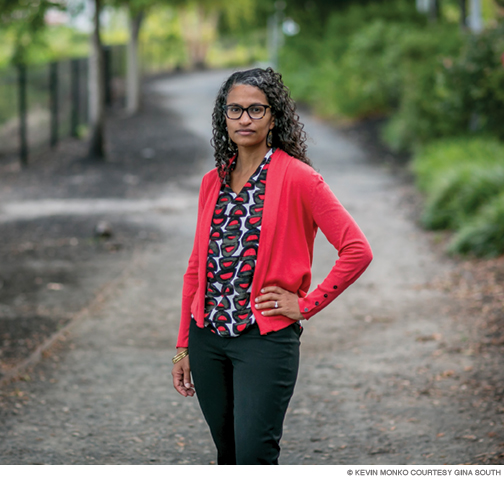
A Penn emergency medicine physician and researcher is leading efforts to dismantle racism in healthcare.
“I’m a Black woman,” says Eugenia (Gina) C. South Gr’12, assistant professor of emergency medicine at the Perelman School of Medicine, “and even though my parents gave me a lot of opportunities to succeed, nothing erases that. Growing up Black meant having certain experiences of racism, and they’ve motivated my desire to do the work I do now.”
Those experiences include the day she noticed the n-word sprayed on a tennis court in the predominantly white Long Island neighborhood where she grew up, and the time a friend mentioned that her pet dog was afraid of South because she was Black. And they were among the reasons that, while still in junior high school, she formed an organization called JUSTICE, which stood for Join Us Students Together In Creating Equality.
She hasn’t stopped fighting since.
“The more you learn, the more you know, the harder it is to look away,” she says. That’s compelled South, a physician-scientist, to take on additional responsibilities beyond the frenzy of the emergency room at Penn Presbyterian Medical Center—a place she loves because “we take all comers, which allows me to get a snapshot about what’s happening in the community.” One is her new position as inaugural vice chair of inclusion, diversity, and equity for Penn’s Emergency Medicine department—part of a larger antiracism initiative across all of Penn Medicine. South is also a senior fellow at Penn’s Leonard Davis Institute of Health Economics, which recently named her to a team of University researchers studying ways to address structural racism within healthcare (see next story).
On top of that, South serves as faculty director for the Urban Health Lab at the Perelman School of Medicine. The lab develops and tests interventions designed to build healthy neighborhoods, such as its recent examination of the long-term impacts of vacant lots on the physical and psychological well-being of residents living near them. When the lots were cleaned and greened by the Pennsylvania Horticultural Society, crime levels dropped and residents surveyed reported significantly increased usage of outside spaces for relaxing and socializing. They also said their mental outlooks had improved and that they felt safer outside their homes.
The lab is now parsing data on similar projects intended to gauge the impact of retrofitting abandoned homes with new doors and windows and completing structural repairs to houses occupied by low-income owners [“Gazetteer,” Jul|Aug 2016]. “The question is,” South says, “if you invest in poorer neighborhoods, do you see positive effects?”
Such environmental factors—which can also include lack of access to healthy food and preventative care—are just the start of the disadvantages faced by Black people when it comes to their health. South mentions pseudo-scientific discussions about purported biological differences between Blacks and whites as an example, or the frequent citing of race as a risk factor for certain diseases. “That’s not actually [about] race,” she says. “That’s racism.” She also notes how the symptoms or complaints of Black people are sometimes dismissed, which has been “traced to the belief during slavery that Blacks were subhuman, that they didn’t suffer pain.” And evidence suggests that some measures of care are improved for Black patients when they’re treated by nonwhite physicians, because “when patients perceive that they are being treated with more respect,” South says, “it engenders trust.”
“No medical professional wants to treat anyone differently,” she continues. “It’s more about the information they’ve received all of their life and the perceptions they’ve formed about Black and brown people. The imaging, the tests, the options they present can all be different as a result and can ultimately lead to disparities.”
As a physician, South has also been on the receiving end of racial assumptions herself. “I can’t tell you the number of times I’ve introduced myself, shown my badge, had a lengthy discussion with someone in a patient’s room,” she says. “And later I come back and that person is on the phone and says, ‘I have to go, the nurse is here.’ No disrespect to the nursing profession, it’s just that that I constantly have to explain my presence.”
Her passion for remedying such biases shows up in South’s participation in the Alliance of Minority Physicians, dedicated to mentoring and recruiting physicians of color at Penn and the Children’s Hospital of Philadelphia (CHOP). The dearth of Black and brown doctors is a nationwide problem, according to the American Association of Medical Colleges, which notes that among the more than one million doctors practicing in 2018, only 5.8 percent identified as Hispanic and 5 percent identified as Black or African American.
That situation has hit home right in her emergency department. “Last year we had zero Black residents,” South says, “so we created a comprehensive plan to improve our numbers with the result being that of this year’s match of 12 residents, five were Black.
“Increasing diversity is not something that will happen unless you have an intentional plan, and we had a plan. Besides gaining buy-in from the leadership and feedback from faculty and residents, we had a formalized interview guide that placed less emphasis on grades and more on experiences and background,” she elaborates. “We also made sure we were bringing in enough underrepresented minority candidates.” As part of this effort, the department held two special interview days where it highlighted its diversity and inclusion efforts, as well as those of the institution.
South’s broad vision for her work in these areas is to “slowly chip away at and take steps towards dismantling racism,” she says. “Beyond increasing diversity among residents and faculty, it means creating a work culture where people don’t feel isolated or undervalued because of their race.
“There are so many different areas that need fixing,” she adds. “There has to be serious attention to evaluating the policies and practices of the institution, for example, and making sure that underrepresented minorities have a place on the board and as department chairs. It won’t be an easy fight, but I’m very optimistic that enough people are committed to this new awakening for the long haul.”
—JoAnn Greco





Excellent article, thanks for sharing